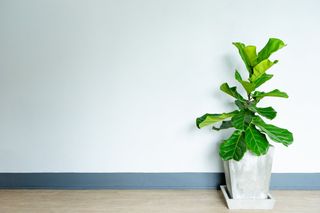Potted Plants That Pop Indoors: Fiddle Leaf Fig & Friends
We all love a nice trailing pothos, a quirky air plant, and a frilly fern in our houseplant collections, but sometimes you just want something big or dramatic that's going to pop. One of those potted houseplants that commands space and demands attention. Enter the fiddle leaf fig and several of its drama-loving cohorts "” these houseplants are no shrinking violets, so use them boldly. Loud and proud, friends, loud and proud.

Fiddle Leaf Fig: (Ficus lyrata) Quite possibly the "it" houseplant du jour, fiddle leaf fig graces the corners of many stylish living rooms (and magazine covers) with its oversized leaves, smooth trunk, and 6-10' height. Give it bright, indirect light, regular watering, plenty of humidity, and a draft-free space, and you're good to go.
Alocasia: (Alocasia sanderiana) Anything that has a common name of "elephant ears" is sure to jumbo-sized. This tropical plant grows anywhere from 2 - 15' tall and 2 - 8' wide, so know which type you have and plan your space (and container) accordingly. Architectural, heart-shaped leaves come in jewellike tones and can grow as large as a couple of feet across. It prefers bright, indirect light, evenly moist (but never soggy, thank you) soil, and high humidity.
Rubber Tree: (Ficus elastica) Out in the wild, rubber tree actually grows up to 60' tall, but in your living room you can expect a starter tree to be a foot tall and grow up to 10' tall. Its medium green glossy leaves are elliptical-shaped with upright stems, giving your interior a decidedly tropical look. Rubber tree prefers a little "” but not too much "” light and water, so you may have to experiment a bit. Bright, indirect light with soil that is damp but not dry or wet seems to do the trick.
Citrus Tree: While most citrus trees love outdoor sun, several grow quite well indoors, especially as an overwintered container plant. Choose a lemon, lime, or orange tree in a dwarf variety "” a 2-3-year-old tree is ideal so you won't have to wait too long for fruiting. Because citrus trees have definite opinions about their accommodations, use potting soil specially formulated for citrus (G&B Organics Palm, Cactus & Citrus Planting Mix is perfect), and give them bright light by a south-facing window. As for watering, aim for "on the dry side of moist" particularly during the winter months, and from spring to summer, feed every 3 weeks with a high nitrogen fertilizer made for citrus.
Variegated Ficus: (Ficus benjamina) Possibly one of the most common of the large houseplants, variegated ficus tree can reach heights of 10-12' with a spread of 4' across, and boasts smaller glossy green and cream leaves. While it's often trained as a tree with one trunk, it is also grown as a more bush-like form with leaves from top to bottom. It loves consistency above all else, so once you find that magic spot of bright indirect light and medium-to-low water "” keep it there, or the tree will voice its discontent by dropping its leaves.

Olive Tree: Want a little bit of Tuscany in your home? Try an olive tree! With its light, sage-hued leaves and airy growth habit (up to 10' tall), it adds a touch of Old World sophistication to any décor. Place it by a sunny, south-facing window, in well-drained soil and let the soil dry out a bit in between waterings to mimic its Mediterranean origins. Most indoor olive trees, however, are of the ornamental rather than fruiting variety, so if you want actual olives, you'll need to grow a different variety outdoors.
Gardening tips, videos, info and more delivered right to your inbox!
Sign up for the Gardening Know How newsletter today and receive a free download of our most popular eBook "How to Grow Delicious Tomatoes."
Pro Tip: Selecting the proper soil for houseplants is critical. Never use regular garden soil "” aim for a high quality soil mix created for indoor containers, like Kellogg Garden Products All Natural Potting Mix. This great soil environment retains moisture, requiring less watering.Â
-
 10 Best Apartment Plants To Turn Your Small Space Into An Oasis
10 Best Apartment Plants To Turn Your Small Space Into An OasisThe best apartment plants can lend an ambience of the tropics, brighten up a space, or add a touch of drama, and turn an apartment into a relaxing oasis.
By Amy Grant
-
 Grow a Bathroom Oasis: 8 Best Bathroom Plants With No Light or Low Light
Grow a Bathroom Oasis: 8 Best Bathroom Plants With No Light or Low LightSome apartment dwellers grow the best bathroom plants with no light or low light. Read how one of our favorite plant lovers does it in the big city.
By Teo Spengler